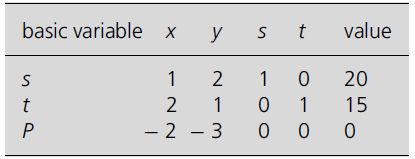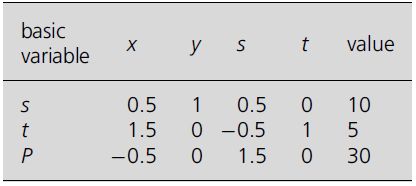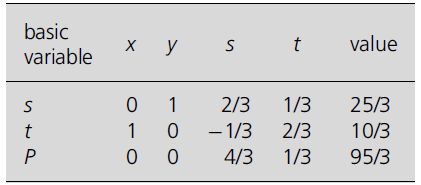simplex method
The simplex tableau is a table which shows the current values for each variable in each constraint, with the last row, known as the objective row, showing the values in the equation derived from the objective function. The simplex algorithm is the process by which that table is manipulated in order to find the optimal solution. In the solution, the algorithm will produce a series of tableaux.
The initial tableau for this problem will be:

The optimality condition is that when the objective row shows zero in all columns representing basic variables and no negative entries, then it represents an optimal solution.
The standard procedure to achieve this condition is to repeat the following set of steps until all the basic variables, x and y, have been set to zero.

The process would now be repeated, and x will now be the entering variable, and the values at step 2 are 20 for s, and 10/3 for t, so t is the leaving variable, and at step 3 the pivotal row will read t, 1, 0, −1/3, 2/3, 10/3.
Repeating step (iv) gives:

For a many-variable problem this would have to be repeated for each variable in turn, but in this simple example the optimality condition is now satisfied and the maximum value of P is 95/3 occurring when s = 4/3 and t = 1/3, corresponding to x = 10/3 and y = 25/3. In this simple problem, the solution could have been found much more quickly by the vertex method, but the simplex method is an important tool because it can be applied to more complicated problems.
- disjunction
- disjunctive normal form
- dispersion
- displacement
- dissection
- dissipative force
- distance
- distance
- distance between two codewords
- distance between two lines
- distance between two points
- distance between two points
- distance from a point to a line
- distance from a point to a plane
- distance‐time graph
- distinct
- distribution
- distribution
- distribution function
- distribution‐free methods
- distributive
- div
- diverge
- divergence
- divergence theorem